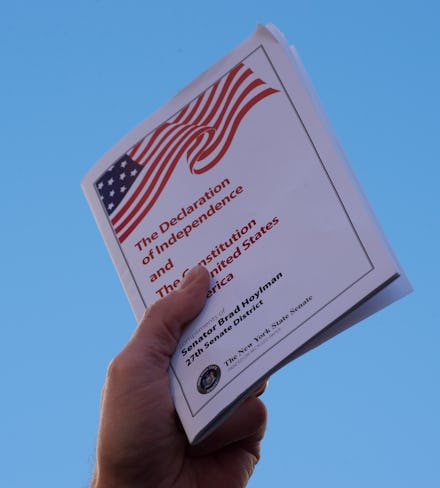What is the 25th Amendment? Explaining the constitutional provision that could take down Trump.

President Donald Trump’s sour mood and erratic behavior has his detractors — and even some of his closest confidants — buzzing about a constitutional amendment that could take down his presidency.
It’s the 25th Amendment, and former White House adviser Steve Bannon has reportedly said it’s the biggest threat to Trump’s presidency.
Trump didn’t know what the 25th amendment was when Bannon brought it up to Trump “several months ago,” according to a report from Vanity Fair.
So let us explain what the 25th Amendment is, and how likely is it to actually take down Trump’s presidency.
What is the 25th Amendment?
The 25th Amendment was ratified in 1967 in the wake of former President John F. Kennedy’s assassination to explicitly lay out the rules of succession if the president resigns, dies or is incapacitated, rendering them unable to carry out the duties of the president.
The provision also lays out the process for replacing a vice president in the case of death or resignation.
The rules are pretty straightforward: If the president dies or resigns, the vice president takes over the job.
If the vice president dies or resigns, the president gets to nominate a successor, who must be confirmed by a majority of both the House and Senate.
Similarly, it sets up a process that allows the president to declare himself “unable to discharge the powers and duties of his office,” and allow the vice president to become the “acting president” in his absence. For example, if a president undergoes surgery and will be under anesthesia, the vice president will assume his duties until he’s able to serve again.
But the provision that is getting attention — and that some say could be the key to Trump’s removal from office — is Section 4 of the amendment.
It states that the vice president and either the majority of his cabinet or Congress can transmit to the president pro tempore of the Senate and the speaker of the House that the president is, “unable to discharge the powers and duties of his office” and that the vice president should, “immediately assume the powers and duties of the office as Acting President.”
The president can write back to those congressional leaders saying he is fit to serve, and can resume his duties.
However the vice president and the majority of either his cabinet or Congress have four days to get back to congressional leadership saying they do not believe the president can carry out his duties.
If that occurs, both the House and Senate must then assemble and take a vote. If two-thirds of both chambers vote to say the president is unable to serve, the vice president will continue to serve as acting president.
Put simply, it’s complicated.
Has the 25th Amendment ever been used?
The short answer is yes — but not in the way that Trump critics want to use the amendment today.
When former Vice President Spiro Agnew resigned in scandal in 1973, President Richard Nixon used it to nominate Gerald Ford as his vice president. Ford was confirmed by the vast majority of both the House and Senate to assume the role.
When President Richard Nixon resigned a year later in 1974 in the wake of the Watergate scandal, Ford became the first nonelected president in history. Ford then used the 25th Amendment to nominate his vice presidential pick in Nelson Rockefeller.
Former Presidents Ronald Reagan and George W. Bush also utilized the 25th Amendment.
On July 13, 1985, Reagan underwent surgery and invoked the 25th Amendment to make Vice President George H.W. Bush acting president from 11:28 a.m. until 7:22 p.m., according to the University of California Santa Barbara’s American Presidency Project.
Former Vice President Dick Cheney also served as acting president twice, in 2002 and 2007, when George W. Bush underwent colonoscopies, according to UCSB. But Bush quickly resumed his presidential duties once the procedures were over.
How likely is it to oust Trump from office?
Some top psychiatrists, as well as a number of Republicans, have come forward to question Trump’s fitness to serve.
They include Sen. Bob Corker (R-Tenn.), who said he’s worried Trump will trigger World War III, and Michael Gerson, a Washington Post columnist and former speechwriter to President George W. Bush.
“It is no longer possible to safely ignore the leaked cries for help coming from within the administration,” Gerson wrote in a column on Thursday. “They reveal a president raging against enemies, obsessed by slights, deeply uninformed and incurious, unable to focus and subject to destructive whims.”
Still, no one should get their hopes up thinking the 25th Amendment will take Trump down.
The process has never been used to oust a president from office.
It would require Vice President Mike Pence and a majority of the cabinet secretaries Trump appointed to go out on a limb to get the process rolling.
“It’s his own people who are making the determination that he’s unfit,” Akhil Reed Amar, a constitutional law professor at Yale University, said in a podcast back in February.
And ultimately, the same Republican Congress that has shown no appetite for a Trump impeachment would have the final say.
It would require two-thirds of the House to vote in favor — a higher bar than impeachment, which only requires a majority House vote.
“It’s even a more demanding vote than impeachment,” Amar said. “Great care was taken to avoid a ‘palace coup’ like situation.”